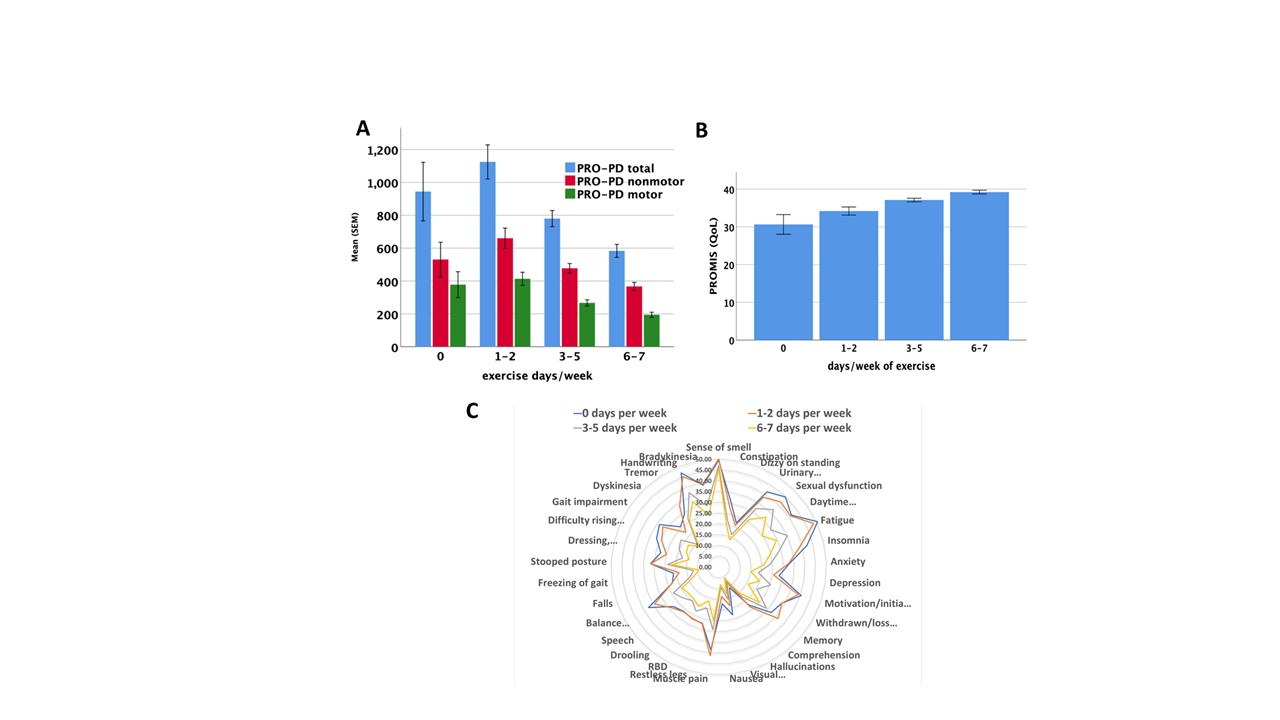Category: Parkinson's Disease: Non-Motor Symptoms
Objective: To examine the association between PA, motor and non-motor symptoms (NMS) and quality of life (QoL) in PD using a validated web-based survey
Background: PA is associated with better health outcomes and a variety of exercise interventions improve motor outcomes in PD. However, the relationship between NMS and PA in PD is not well-characterized. Here, we examine the relationship between PA, NMS and QoL in PD subjects using a previously validated patient reported outcome scale (PRO-PD)(1).
Method: We analyzed data from 422 subjects reporting a clinical diagnosis of PD. ‘CAM Care PD’ is an ongoing internet-based natural history study attempting to identify modifiable variables associated with rate of PD progression (1). PA was reported as days/week exercising more than 30 minutes. For group comparisons (Figure1) activity was binned as 0, 1-2, 3-5 or 6-7 days/week. The relationships between outcome variables (PRO-PD, PRO-PD motor, PRO-PD non-motor (PRO-PD NMS) and the QoL scale Patient-Reported Outcomes Measurement Information System (PROMIS)) and PA were assessed in linear regression models controlling for age, sex, income and disease duration. A radar chart with individual symptoms categorized into motor and non-motor regions, was used to visualize symptomatic trends (Fig1C).
Results: The cohort was comprised of 56.6% women. Mean(SD) age and disease duration were 65.4(8.5) and 6.8(5.0) years, respectively. PRO-PD total, motor and NMS scores decreased (indicating less severe symptoms) and PROMIS scores increased (indicating greater quality of life) with increasing levels of PA (Fig1AB). Most, but not all, motor and NMS domains were inversely associated with PA (Fig1C). Men and women reported similar levels of activity and scores for most symptom domains. However, in multivariate regression models, the association between PA and symptom severity was significant only in women.
Conclusion: Exercise is associated with improvements in motor symptoms, NMS and QoL in PD. These cross-sectional data may imply that motor and NMS in PD are a hindrance to increased PA or that increased PA reduces PD severity. Sex differences in the association between PA and NMS warrant further investigation and may influence clinical recommendations. While many guidelines recommend 5/days week of exercise, these data imply that even more may be better.
References: 1) Mischley LK, Lau RC and Weiss NS. (2017) npj Parkinson’s Disease. 3:20.
To cite this abstract in AMA style:
J. Morley, I. Subramanian, J. Farahnik, L. Mischley. Physical activity (PA), patient reported outcomes and quality of life in Parkinson’s disease( PD) [abstract]. Mov Disord. 2021; 36 (suppl 1). https://www.mdsabstracts.org/abstract/physical-activity-pa-patient-reported-outcomes-and-quality-of-life-in-parkinsons-disease-pd/. Accessed April 2, 2025.« Back to MDS Virtual Congress 2021
MDS Abstracts - https://www.mdsabstracts.org/abstract/physical-activity-pa-patient-reported-outcomes-and-quality-of-life-in-parkinsons-disease-pd/

